Bigger queens, better queens - part 1

The majority of books and articles I’ve read on queen rearing emphasise that bigger queens are better queens. The rationale is simple. Bigger queens are better because their larger abdomens contain more ovarioles and larger spermatheca. Without getting too anatomically technical, these are the reproductive organs for producing eggs and storing sperm. Large queens should therefore be able to lay more eggs for longer; greater fecundity, as scientists call it.
More eggs – all other things being equal – mean larger, stronger, colonies, which means more honey … or more nucs, or propolis or pollination or whatever you keep bees for.
There is good support – both anecdotal and scientific – for the benefits of larger queens, dating back decades {{1}}.
Because of this, instructions on queen rearing usually stress the importance of feeding your cell raising colonies well, even supplementing them with syrup and pollen if needed. This benefits larval development, so increasing the size of the resulting queen.
However, very recent studies suggest that the origin of the starting material – the larva – used for cell raising has a fundamental influence on the finished queen.
These studies demonstrate, for the first time, a maternal effect in honey bees.
The results imply that the methods used to rear almost all queens (by commercials and amateurs) will result in undersized, poorer quality, queens than could be achieved.
Finally, I think there are implications from these studies that might encourage more beginners to start queen rearing.
This is the first of a three part series on queen rearing. Parts two and three will follow in due course (though perhaps not immediately).
Today I’ll cover the science. In the future, I’ll discuss the practical beekeeping … stay tuned.
‘Typical’ methods used to rear queens
Of course, starting any description of a beekeeping method with the word typical means I’ll be swamped by a tsunami of comments like “I’ve never done it that way”.
Bear with me, this bit just sets the scene …
I define ‘active’ queen rearing as any method that does not rely on the natural production of swarm cells.
In these ‘active’ methods, a colony is made receptive to producing new queens, for example by removing the original queen. Under the ‘emergency response’ this induces, the colony starts to rear new queens if they have – or are provided with – suitable starting material.
By preference, a colony rears new queens from 3 day old eggs, but they can also use very young larvae.
Beekeepers exploit this response by introducing selected young larvae (from a ‘good’ colony), often presented vertically in wax or plastic cups.
These larvae are fed copious amounts of royal jelly, develop rapidly and emerge as virgin queens.
I hope that’s a generic enough description that most readers both recognise and can accept.
Before moving on, I want to stress one critical point … when queen rearing using the emergency response, the larvae selected to be reared as new queens are worker larvae.
For commercial or many amateur queen rearing approaches, these young worker larvae are grafted from a donor colony.
Grafting involves the manual transfer of a young larva from a worker cell to a vertically-orientated cell in the cell raising colony. This vertical orientation triggers the copious feeding with royal jelly, and this rich diet induces the changes in methylation and gene expression that convert what would have developed into a worker bee into a new queen.
Hundreds of thousands of queens are produced like this every year.
Maternal effects
A maternal effect is the causal influence of the mother on the phenotype of the offspring.
The phenotype is the appearance or performance of an individual. The OED defines it as:
The sum total of the observable characteristics of an individual.
Obviously, there is a genetic relationship between the queen and the egg she lays. However, this is not a maternal effect.
The latter is more specifically taken to mean a greater investment by the mother (queen in the case of honey bees) in certain young that are being reared.
For example:
- in some ducks and fish, the female makes a greater investment in egg production (i.e. laying larger eggs) if the perceived quality of the mate is higher
- the ant Pheidole pallidula produces larger eggs during the part of the season in which sexual generations are produced
In these well-documented examples, the mother produces better ‘quality’ eggs only under certain circumstances. This may increase the long-term chances for the survival of the progeny.
Until a few years ago, there had been almost no analysis of the maternal effect in honey bees. Queen development was considered to be entirely due to the environmental conditions experienced by the larva. This is exploited when we rear queens from grafted worker larvae.
However, between 2019 and 2023 three related studies were published demonstrating that queens lay larger eggs destined to develop into queens, and that the resulting new queens are larger and more productive.
I’m mainly going to focus on studies by Wei et al., (2019) and Yu et al., (2023) as these contain results that are easier to describe and most accessible without the need for a doctorate in molecular genetics.
A testable hypothesis
Like all good experiments, the initial question posed was relatively straightforward:
Do queens produce larger eggs when laying in queen cells?
Which, of course, immediately prompts the obvious follow-up question …
Do larger eggs generate larger (or better) queens?
To test this hypothesis, it was necessary to induce a queen (or several, as there are many repeats in this study) to lay eggs in both worker and queen cells, to characterise the eggs laid, and then to rear them into new queens under standardised conditions.
The difference between queen cells and worker cells is primarily size {{2}}. Worker cells are narrower than queen cells.
The authors used a modified system first described in the American Bee Journal (Pan et al., 2013). This is broadly similar to the Nicot Cupkit system familiar to many beekeepers.
A sheet of plastic foundation was engineered to contain removable cell cups on short spigots. The cups were either small or large diameter – representing worker or queen cells. The short spigot aided handling the egg-containing cell cup without touching the egg.
After the queen had laid in the cell cups they could be removed from the surrounding comb and presented, vertically, on a cell bar frame in a colony set up to rear queens.
Worker and queen cell cups were 4.9 mm or 9.7 mm in internal diameter respectively. The ABJ article only describes one size. You’ll need to read it and the methods section of Wei et al., (2019) for full details.
Remember
As is usual … there are lots of repeats in the study. Different queens, different colonies etc. Results are either statistically significant, meaning very unlikely they are due to chance, or not statistically significant. The latter does not mean that they are due to chance, but that they could be.
For brevity, I’m going to focus on the statistically significant results and not give you all the gory details about numbers of repeats, standard deviation or the statistics. If the results are not significant but are interesting, I’ll make that clear.
Pour yourself a stiff drink (or two) and read the paper(s) yourself; they are all Open Access and freely available.
You won’t regret it {{3}}.
Queens lay larger eggs in queen cells
Eggs change in size during development. Therefore, the authors standardised both the duration of egg laying and the timing of egg sizing. Queens were caged on frames containing queen cell cups for 6 hours and then transferred for a further 6 hours to a frame containing worker cell cups. The weight of eggs was determined as soon as the queen was removed, i.e. they were no more than 6 hours old.
Eggs laid in queen cell cups (QE = queen eggs) were 13.26% heavier, 2.43% longer and 4.13% thicker than eggs laid in worker cell cups (WE = worker eggs).
For the remainder of the study, Wei et al., (2013) compared queens reared from these QE or WE. I’ll term these QE- or WE-queens.
However, for comparison, they additionally incubated some of the WE in the original colony until they were 2 day old larvae (designated 2L) before transferring them to the queen rearing colony. These are older than would be used for queen rearing, and would be expected to produce substandard queens (I’ll call these 2L-queens) … bear that in mind as I discuss the results.
Larger eggs produce heavier queens
Queen and worker eggs (QE and WE) and 2L larvae were reared in the same queenless cell raising colonies, the resulting queen cells were caged after capping and the queens that subsequently emerged were collected and weighed.
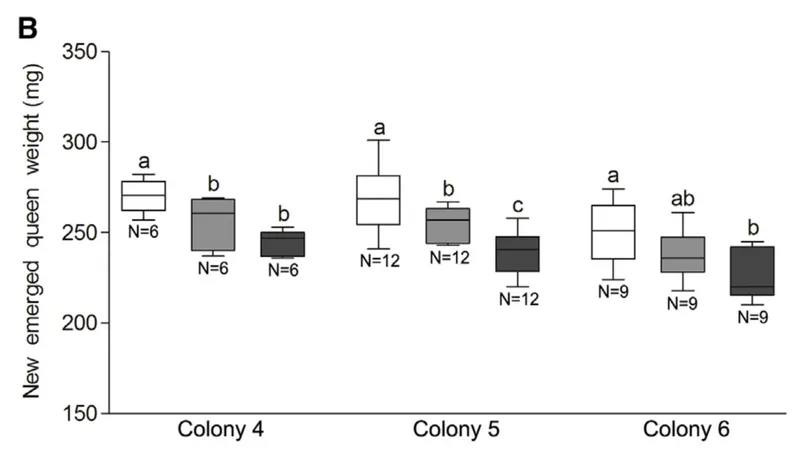
Queens reared from eggs laid in queen cells are heavier (from Wei et al., 2019). Note, dark boxes are 2L-queens
In the five cell raising colonies used (only 3 shown above), QE-queens were the heaviest, and were significantly heavier than WE-queens in 3/5 colonies. The difference in weight between the QE- and WE-queens was ~10%.
2L-queens were generally the lightest overall, though they were not always significantly lighter than WE-queens.
Heavier queens have more ovarioles
Ovarioles are important … we’ve known since the early 70’s that queens with more ovarioles are more fecund.
QE-queens had 13% more ovarioles than 2L-queens, a significant difference. However, QE- and WE-queens did not have significantly different numbers of ovarioles in the first study.
I’ve not bothered showing yet another graph to illustrate this result.
In a recent follow-up study by the same authors (Yu et al., 2023) they analysed the reproductive ability of these queens. In this study, they also re-quantified ovariole number and the weight of the thorax of the queens.
Why thorax weight? Thorax weight is important as it reflects the size and strength of the flight muscles as well as being indicative of the overall size of the queen. The queen may not fly much – a few orientation and mating flights, and when swarming – but when she does it is important that she flies strongly.
Like the weight overall (see above), the thorax weight of QE-queens was significantly greater than WE- or 2L-queens (which were also significantly different). In addition, in this more recent study, the ovariole number in QE-queens was significantly greater than WE- or 2L-queens when analysed.
Why was there a difference in the more recent study? I don’t know, and the authors do not comment …
Reproductive quality of reared queens
You can measure reproductive quality of queens in two general ways; the number of eggs laid and the colony growth potential, measured in terms of capped worker cells.
QE-queens laid significantly more eggs than 2L-queens, but the other comparisons (QE vs. WE or WE vs. 2L) were not significantly different. For interest, I dug into the numbers and looked at the queen laying rates which were ~250-450 in 6 hours, so ~55 per hour or ~1 per minute … all the time. What a life!
At 12 days the authors measured capped worker cells where the results were similar in ranking and significance to the egg laying results i.e. QE >> 2L, but no significant difference between the other two comparisons. However, at this stage the ranking was a bit more obvious … QE > WE >2L, with average numbers of capped cells at 12 days being ~6,500, ~5,500 and ~4,000 respectively {{4}}
The final difference they quantified in the reproductive capacity of reared queens was a little odd (at least, it seemed that way to me). Eggs laid by QE-queens were significantly longer than those laid by WE- or 2L-queens, but were a similar weight and thickness.
I’m not sure what this means.
A quick summary …
Although there is a bit of variation, the take home message so far is that queens reared from eggs laid in queen cells (QE-queens) were:
- heavier, with a larger thorax
- had more ovarioles
- laid more eggs, and
- produced more brood
Those are all features you would probably want to see in your queens.
How do progeny queens or workers reared from QE-queens perform? Are they better than progeny from WE- and 2L-queens?
Arguably, this is even more important than fecundity per se.
Size and productive capacity of worker progeny
The size of workers that developed from eggs laid by the three queen types was determined. Worker progeny from QE-queens were significantly heavier than from WE- or 2L-queens, and they had longer and wider wings.
Productive capacity is a term that covers a wide range of worker activity; water, nectar or pollen collection, honey stored, larvae fed, corpses removed, cells cleaned etc.
Just about the easiest of these to quantify is pollen collection. You rear brood from QE-, WE- or 2L-queens, label several hundred newly-emerged workers and then – once they have matured into foragers – you capture returning marked pollen-carrying bees and weigh the contents of their pollen baskets {{5}}.
Workers from QE-queens collected more pollen than workers from 2L-queens, though not significantly more than workers from WE-queens.
Why are workers from QE-queens bigger?
One possibility is that they are more ‘attractive’ to nurse bees, so get more attention and are fed more, or more often, or both.
Whilst this can be measured (you need to use an observation hive, barcoded workers and a ‘shedload’ of image analysis) an alternative strategy is to transfer one day old larvae into queen cells and then quantify the amount of royal jelly that accumulates in the cells over a 48 hour period. More ‘attractive’ larvae will be fed larger amounts of royal jelly.
Larvae from QE-queens accumulated significantly more royal jelly than larvae from WE- or 2L-queens.
And, by logical extension, if eggs laid by QE-queens received better feeding you would expect queens reared from these well-fed larvae would develop into bigger queens … and they do.
Queen size
To avoid confounding this part of the analysis with the – now known – differences in queen size from eggs laid in queen cells, worker cells or from 2 day old larvae, the authors used standard queen rearing techniques – grafting 2 day old worker larvae derived from QE-, WE- or 2L-queens {{6}} – from standard worker cells into queen cups.
Queens reared from worker larvae laid by QE-queens were significantly larger – defined by thorax length and width – than queens from similarly aged larvae from either WE- or 2L-queens. Disappointingly, they didn’t quantify other useful parameters such as weight or ovariole numbers {{7}}.
OK, so where are we?
That’s a lot to think about.
Like many experiments, the results are not absolutely ‘cut and dried’ … there are a few weird discrepancies, and one or two experiments should have been repeated to get more statistically robust data. The methods and results on royal jelly quantification are contradictory and very poorly described; I’ve done my best to interpret what was done.
I’ve omitted entirely discussion of the differential gene expression in the original Wei et al., (2019) paper and the more extensive analysis of gene methylation reported in the related He et al., (2021) study. Suffice to say, when QE-queens were compared with WE- or 2L-queens there were significant differences {{8}} in:
“… mTOR, MAPK, Wnt, Notch, Hedgehog, FoxO, and Hippo signalling pathways that are involved in regulating caste differentiation, reproduction and longevity.”
Which, the cognoscenti {{9}} will appreciate, is exactly what you would expect, and which explains many of the phenotypic differences in the resulting queens.
And, even if you’re not a member of the cognoscenti, I hope you can enjoy the names of genetic control pathways like Hippo and Hedgehog.
What are the conclusions and implications of this study?
Conclusions
The first and most important take home message is that queens reared from eggs laid in queen cells are usually bigger and better than those reared from worker cell-derived eggs. Furthermore, they are always bigger and better than from queens reared from two day old worker larvae.
We’ve long known that ‘old’ larvae are a poor starting material for high quality queens, but the benefits – in terms of fecundity and presumably other characteristics not (yet) measured – of eggs laid in queen cells over those laid in worker cells is new.
This is a maternal effect and – amazingly considering the number of studies on their reproduction – it’s the first clear evidence that it occurs in honey bees. Apparently {{10}} studies from 50 years ago suggested that there was a relationship between egg and queen size, but the 2019 paper by Wei and colleagues confirms it.
This maternal effect is not restricted to progeny queens. Workers that develop from eggs laid in worker cells by QE-derived queens are also better quality, at least based upon the limited analysis conducted.
This maternal effect likely benefits the entire colony.
Wide, wider, widest
Queens can determine the difference in size between worker and drone cells using their forelegs. They use this to selectively lay unfertilised eggs in drone comb. Perhaps a similar mechanism operates to identify queen cells?
But knowing the size of the cell is only half the story … can queens also measure large or small eggs before oviposition, selectively laying large eggs in queen cells?
Alternatively, and possibly more realistically, perhaps queens pause before egg laying when they find a queen cell? It is known that delayed oviposition results in bigger eggs with more yolk protein.
Implications for queen rearing.
Grafting-based queen rearing methods – which account for almost all commercially reared queens – use selected day-old worker larvae. As shown above, these likely produce inferior queens to those reared from eggs laid in queen cells … inferior as defined by size, ovariole number and in the quality of eggs and brood they produce.
Repeated rounds of grafting-based queen rearing would be expected to have a cumulative and long-term deleterious effect on the quality of the queens, and the colonies that they head.
How do you think the last queen you purchased was reared?
And what was her mother reared from?
And her grandmother?
What about her great-grandmother?
Yes, almost certainly, from grafted day-old worker larvae.
Implications for beginners
Grafting, or the perceived need to graft, is one of the major disincentives stopping beginners attempting to rear their own queens.
However, if better queens really are produced from eggs laid in queen cells, it suggests that alternate methods should be used that do not involve grafting.
This should encourage some of the grafting-averse beekeepers to start rearing queens.
That, and the methods involved, will be the subject of another post on this topic.
Notes
Since I’ve already drafted parts of the two follow-up posts to this article (and have no intention of either writing something different or regurgitating them in their unfinished state as responses to comments!) please focus on the main conclusions of these studies in any comments, rather than the potential implications, particularly for beginners. The identification of a maternal effect is important for our understanding of honey bee reproductive behaviour.
References
He, X.J., Wei, H., Jiang, W.J., Liu, Y.B., Wu, X.B., and Zeng, Z. (2021) Honeybee (Apis mellifera) Maternal Effect Causes Alternation of DNA Methylation Regulating Queen Development. Sociobiology 68: e5935 https://doi.org/10.13102/sociobiology.v68i1.5935.
Pan, Q-Z, Wu, X-B, Guan, C. and Zeng, Z-J (2013) A new method of queen rearing without grafting larvae ABJ 153(12):1279.
Wei, H., He, X.J., Liao, C.H., Wu, X.B., Jiang, W.J., Zhang, B., et al. (2019) A Maternal Effect on Queen Production in Honeybees. Current Biology 29: 2208-2213.e3 https://doi.org/10.1016/j.cub.2019.05.059.
Yu, L., He, X., Shi, X., Yan, W., and Wu, X. (2023) Honey bee maternal effects improve worker performance and reproductive ability in offspring. Front Cell Dev Biol 11: 1156923 https://doi.org/10.3389/fcell.2023.1156923.
{{1}}: Perhaps I should have written this first? I think I need to write a prequel.
{{2}}: I’ll return to this point in a later post.
{{3}}: The drink, that is …
{{4}}: Yes, the maths don’t quite add up; 3.5 days of egg laying @ 55 h-1 is only ~4,600 eggs … let’s not worry about it. Perhaps queens lay at a greater rate at night?
{{5}}: Remember, ‘easiest’ is a relative term.
{{6}}: I think 2 day larvae are too old and would have done this part of the study differently.
{{7}}: Almost certainly because they used two day old larvae as the starting material … I suspect there’s another manuscript in the offing.
{{8}}: A verbatim quote from the abstract of He et al., (2021).
{{9}}: Those with a doctorate in molecular genetics.
{{10}}: I’ve not been able to source the full paper – you can read the abstract here.
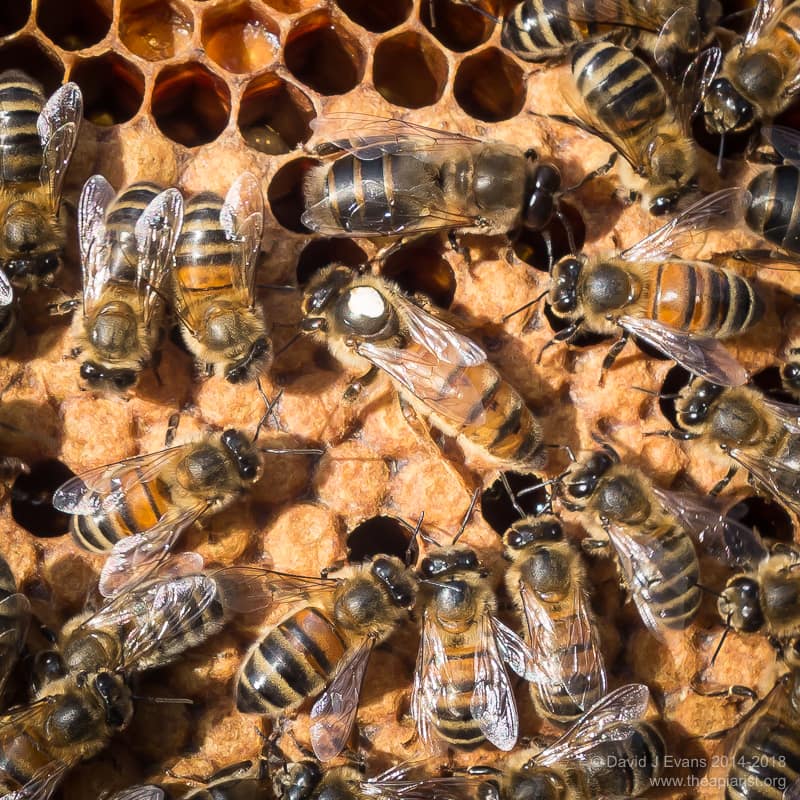
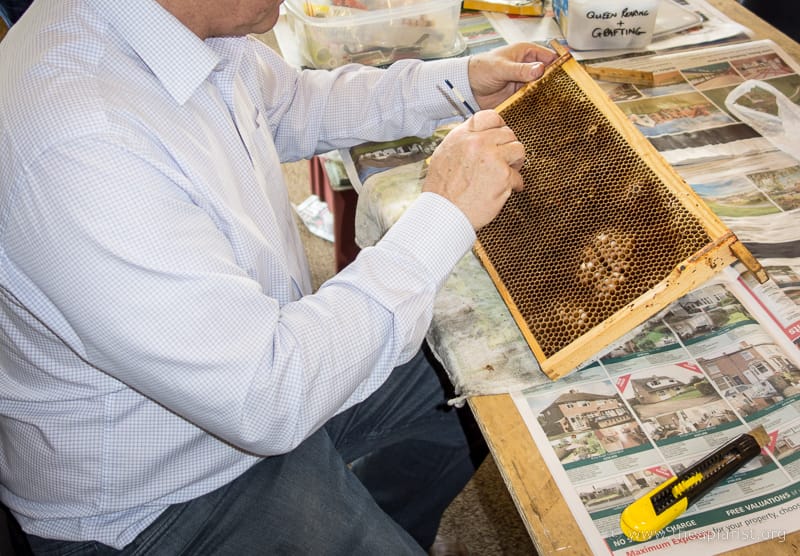
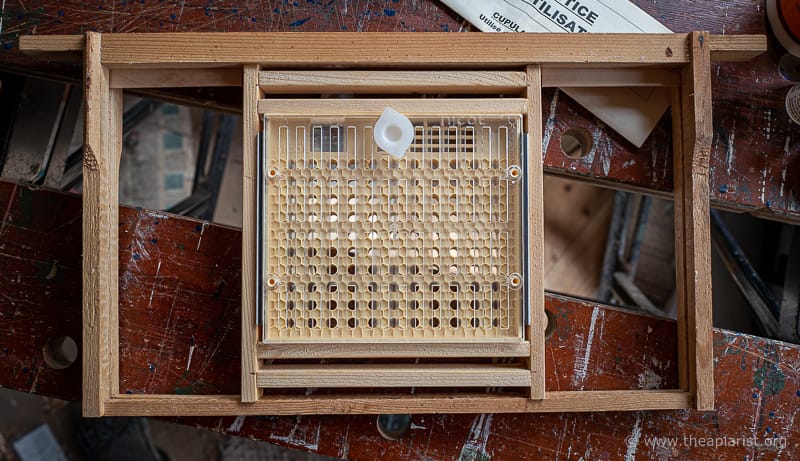
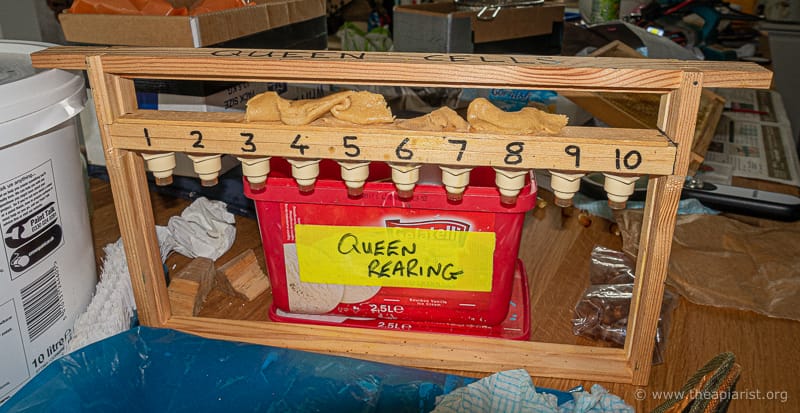
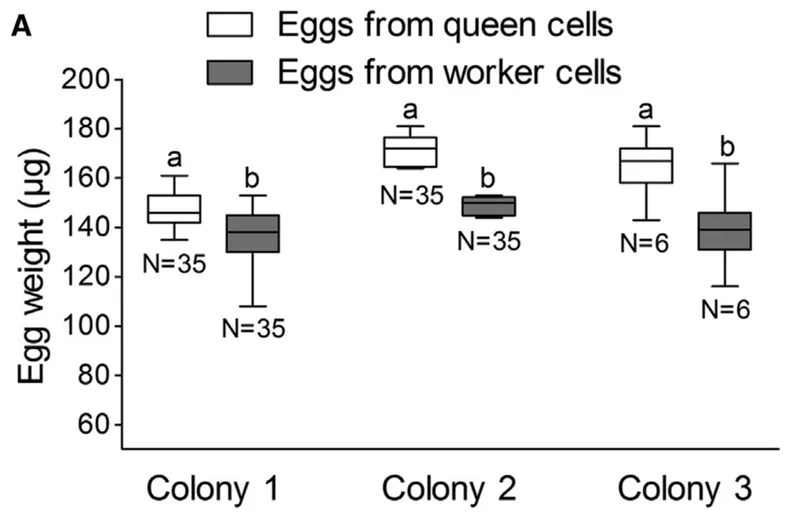
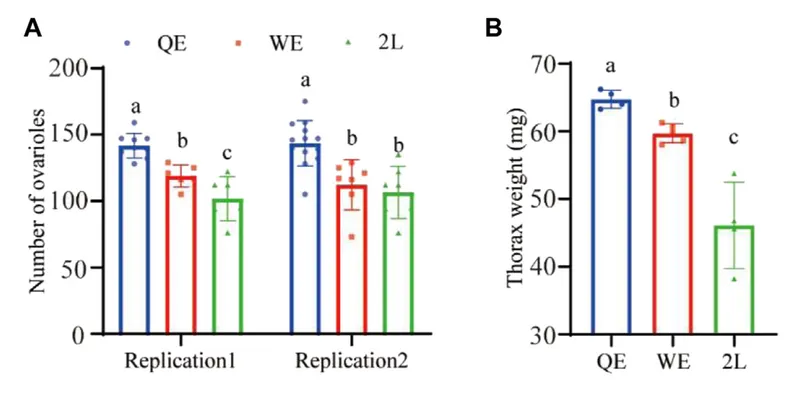
Join the discussion ...